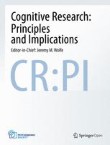Cognitive Research: Principles and Implications is affiliated with The Psychonomic Society
Teaching students to think spatially through embodied actions: Design principles for learning environments in science, technology, engineering, and mathematics
Spatial thinking is a vital component of the science, technology, engineering, and mathematics curriculum. However, to date, broad development of learning environments that target domain-specific spatial think...
